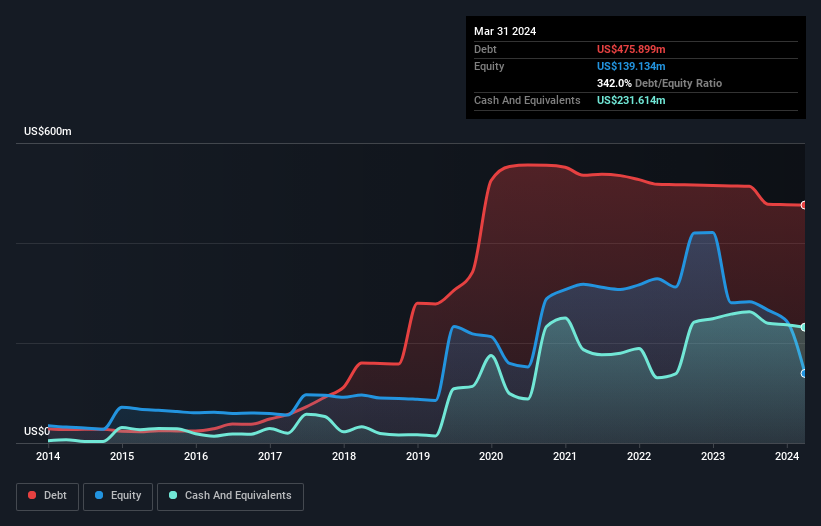The external fund manager backed by Berkshire Hathaway's Charlie Munger, Li Lu, makes no bones about it when he says 'The biggest investment risk is not the volatility of prices, but whether you will suffer a permanent loss of capital.' When we think about how risky a company is, we always like to look at its use of debt, since debt overload can lead to ruin. We can see that Upland Software, Inc. (NASDAQ:UPLD) does use debt in its business. But should shareholders be worried about its use of debt?
When Is Debt Dangerous?
Debt assists a business until the business has trouble paying it off, either with new capital or with free cash flow. If things get really bad, the lenders can take control of the business. However, a more usual (but still expensive) situation is where a company must dilute shareholders at a cheap share price simply to get debt under control. By replacing dilution, though, debt can be an extremely good tool for businesses that need capital to invest in growth at high rates of return. When we think about a company's use of debt, we first look at cash and debt together.
Check out our latest analysis for Upland Software
What Is Upland Software's Debt?
You can click the graphic below for the historical numbers, but it shows that Upland Software had US$475.9m of debt in March 2024, down from US$514.1m, one year before. However, it does have US$231.6m in cash offsetting this, leading to net debt of about US$244.3m.

How Strong Is Upland Software's Balance Sheet?
Zooming in on the latest balance sheet data, we can see that Upland Software had liabilities of US$123.4m due within 12 months and liabilities of US$492.4m due beyond that. Offsetting these obligations, it had cash of US$231.6m as well as receivables valued at US$37.7m due within 12 months. So its liabilities outweigh the sum of its cash and (near-term) receivables by US$346.5m.
This deficit casts a shadow over the US$70.4m company, like a colossus towering over mere mortals. So we definitely think shareholders need to watch this one closely. After all, Upland Software would likely require a major re-capitalisation if it had to pay its creditors today. When analysing debt levels, the balance sheet is the obvious place to start. But it is future earnings, more than anything, that will determine Upland Software's ability to maintain a healthy balance sheet going forward. So if you're focused on the future you can check out this free report showing analyst profit forecasts.
Over 12 months, Upland Software made a loss at the EBIT level, and saw its revenue drop to US$292m, which is a fall of 7.6%. That's not what we would hope to see.
Caveat Emptor
Over the last twelve months Upland Software produced an earnings before interest and tax (EBIT) loss. Indeed, it lost a very considerable US$29m at the EBIT level. If you consider the significant liabilities mentioned above, we are extremely wary of this investment. That said, it is possible that the company will turn its fortunes around. But we think that is unlikely since it is low on liquid assets, and made a loss of US$141m in the last year. So we think this stock is quite risky. We'd prefer to pass. When analysing debt levels, the balance sheet is the obvious place to start. But ultimately, every company can contain risks that exist outside of the balance sheet. We've identified 3 warning signs with Upland Software , and understanding them should be part of your investment process.
If, after all that, you're more interested in a fast growing company with a rock-solid balance sheet, then check out our list of net cash growth stocks without delay.
New: AI Stock Screener & Alerts
Our new AI Stock Screener scans the market every day to uncover opportunities.
• Dividend Powerhouses (3%+ Yield)
• Undervalued Small Caps with Insider Buying
• High growth Tech and AI Companies
Or build your own from over 50 metrics.
Have feedback on this article? Concerned about the content? Get in touch with us directly. Alternatively, email editorial-team (at) simplywallst.com.
This article by Simply Wall St is general in nature. We provide commentary based on historical data and analyst forecasts only using an unbiased methodology and our articles are not intended to be financial advice. It does not constitute a recommendation to buy or sell any stock, and does not take account of your objectives, or your financial situation. We aim to bring you long-term focused analysis driven by fundamental data. Note that our analysis may not factor in the latest price-sensitive company announcements or qualitative material. Simply Wall St has no position in any stocks mentioned.
About NasdaqGM:UPLD
Upland Software
Provides cloud-based software applications under the Upland brand name in the United States, the United Kingdom, Canada, and internationally.
Very undervalued with moderate growth potential.
Similar Companies
Market Insights
Weekly Picks

Solutions by stc: 34% Upside in Saudi's Digital Transformation Leader


The AI Infrastructure Giant Grows Into Its Valuation
Recently Updated Narratives


The "Landlord of Orbit" – A Deep Value Play Ahead of the Starlab Era


The "AI-Immunology" Asymmetric Opportunity – Validated by Merck (MSD)


The Hidden Gem of AI Hardware – Solving the Data Center Bottleneck
Popular Narratives


MicroVision will explode future revenue by 380.37% with a vision towards success


NVDA: Expanding AI Demand Will Drive Major Data Center Investments Through 2026



